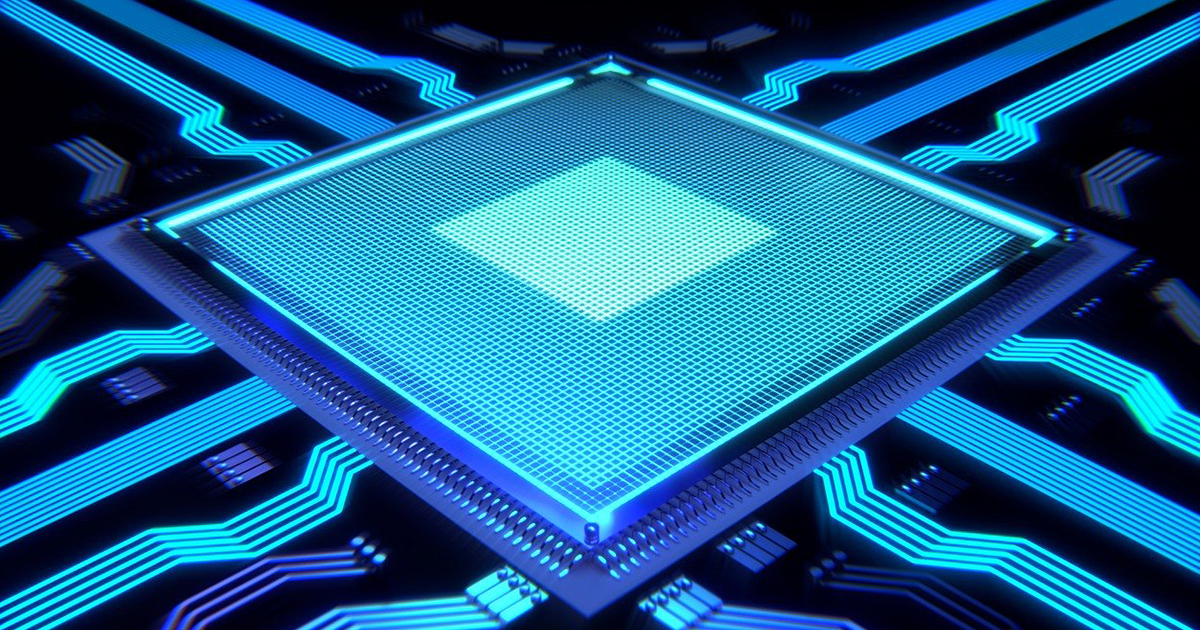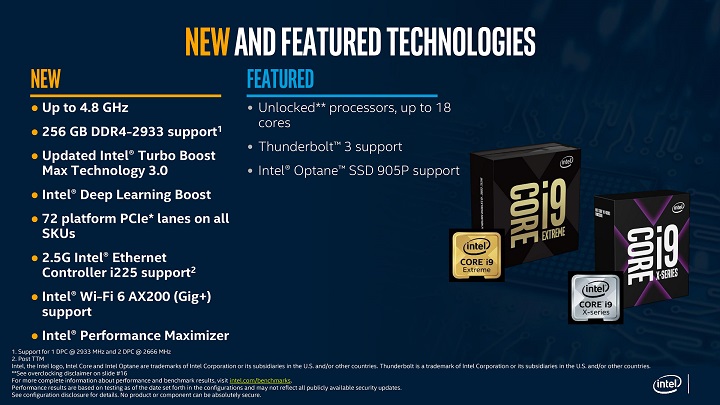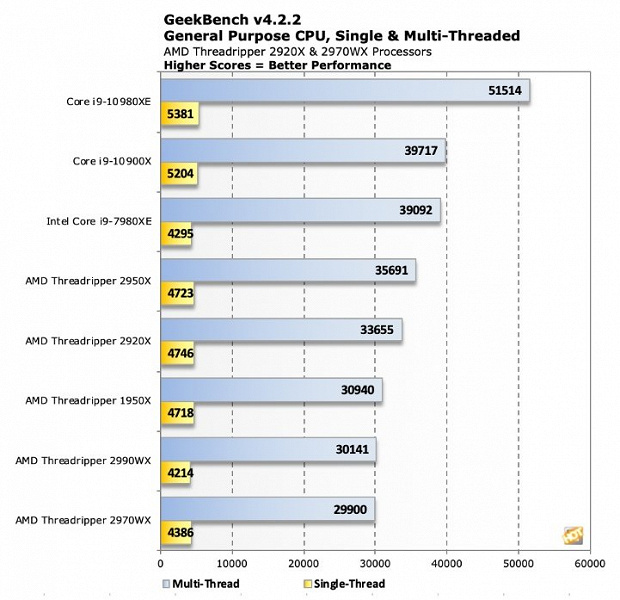
What is more important, more gigahertz or a new technical process?
Who is developing and who is stagnating and on the processor of which company to build a top-end system in 2020?
Let's try to answer these questions in our comparison of two monster processors from Intel and AMD.
Reimagining HEDT processors, ultimate solutions for demanding users

In the spring of 2019, Intel presented its new processors designed to take the company to a leading position in the HEDT processor niche. Intel Core i9-10980XE became the leading processor of the rethought line and direction as a whole.
The Intel i9 10980XE is packed with 18 cores and 36 threads, has 24.75 MB cache and boasts a 3.0 GHz clock speed with Turbo boost Max support.
The most powerful Intel HEDT processor line, the 10980XE, was intended to regain the company's leading position and leave AMD far behind, in fact, Intel had to adapt to a competitor.
Due to the decrease in demand for processors like HEDT and the appearance of a similar line from AMD at a lower price - Intel had to "moderate appetites" and release its top-end processor at a suggested retail price of $ 979 at the time of its release.

The key features of this processor was the ability to use the proprietary technology Turbo Boost 3.0 - overclocking the cores from the standard 3.0 GHz to 4.8 GHz after using the utility. Intel at the time of the release of this processor positioned it as a new round in the HEDT segment thanks to the improvement of the 14 nanometer process technology, but did not expect such a powerful response from AMD.
Development or modernization
Intel fans were quite cool about the new processor. After its rethinking, the production of other models in the line was suspended - which is why those who wanted to buy a HEDT-type processor from Intel simply had no choice. If you as a customer wanted to stay loyal to Intel and get the ultimate solution, all you had to do was buy a Core i9 10980XE processor.
Despite the line cut and price reduction under the pressure of cheaper processors from AMD, Intel managed to create an ultimatum solution - at least not for long.
256GB RAM and Vulnerability Fixes That Intel Changed to Be in the Lead Again
In order not to be unfounded, speaking about the ultimatum of its product, Intel has made a number of changes to the updated version of the top processor of the Core X line.

This is how the specification of DDR4 memory at a frequency of 2933 MHz became available to us, in the case of installing a pair of DIMMs per channel, Intel offers a frequency of 2666 MHz. Intel Core i9 10980XE is capable of running with 256GB of RAM, making it a great solution for working with large amounts of information and video rendering, characterizing its multitasking.
Despite all the positive aspects, including the built-in Intel utility - Turbo Boost max 3.0 - the company failed to overclock all processor cores. The difference in frequencies is such that if the conditionally first core has a frequency of 4.8 GHz after Turbo boost max 3.0, then the frequency of the last processor core will be 3.8 GHz even after overclocking.
Such overclocking cannot be called bad, but it cannot be called the most effective. One of the problems with overclocking Intel processors is the terms dictated by the company itself. Experienced overclockers have no room for thought - after all, any overclocking of Intel processors becomes problematic due to the company itself curtailing the possibility of using the full potential of its processors.
Do not forget about the vulnerabilities of this line of processors. Despite all efforts to close all the holes in the system, Intel opened others by closing some vulnerabilities.
In turn, AMD did not create additional problems for users who want to get the maximum available power from the company's products. AMD allows overclocking of Ryzen processors and RAM even on motherboards with A-chipset, despite the fact that due to the number of power circuits it is better not to carry out such experiments.
The latest generation of Intel processors has raised many questions, the seemingly ultimatum product quickly lost its uniqueness due to the release of an updated line of HEDT-type processors from AMD. The top processor Intel Core i9 10980 XE could not stand the competition, which only exacerbated the situation for Intel.
At AMD, on the contrary, things are going uphill, as regrettable as it may sound, but it seems that the company will soon occupy the Intel niche in the processor market, and Intel has every chance of sinking into oblivion with the advent of the era of processors on ARM.
AMD's Response, Lineup Refresh, and Outrageous Power
AMD went the other way by presenting its updated line of Ryzen Threadriper processors at CES 2020, which caused a shock from Intel fans.

The top processor in the updated lineup was the Ryzen Threadripper 3990x, which uses 64 cores and 128 threads against Intel's top solution - 18 cores and only 36 threads.
The new processor from AMD is also a modification of its counterpart, which has already been published, but AMD, unlike Intel, took the EPYC 7202 P server processor as a basis for the new model.

Threadripper 3990x reduced the available number of memory channels, due to the use of this processor not in servers, but in desktop solutions, but compensated for this loss by increasing the clock frequency from the base 2.9 GHz to 4.3 GHz within one thermal package.
AMD does not intend to impose any restrictions on motherboards, the Ryzen Threadripper 3990x processor will work on all motherboards with the sTRX4 socket. The company also states that ordinary DDR4 memory with a clock frequency of 3200 MHz is suitable for this processor, only adding that for correct operation, the desired amount of RAM should be equal to 1 GB per processor core.

AMD is positioning this processor as an ideal solution for content makers. The render speed of a system with a single core of the Threadripper 3990x processor is 1.5 times faster than the render speed of a competing system with a Xeon platinum processor with 28 cores.
Thus, we can say that if you are engaged in content creation, rendering and editing, the Ryzen Threadripper 3990x processor will be the best solution from the desktop processor currently on the market.
From words to deeds, comparison of Intel Core i9 10980XE and AMD Ryzen Threadripper 3990X
In the table below, we compared two top processors from AMD and Intel

As we can see, based on the information in the table, these processors are located in completely different price categories, the cost of a top AMD product is almost 4 times higher than its opponent, but it offers 7 nanometer process technology, 64 cores versus 18 from Intel, and the best rendering performance ...
Which platform to choose for building a powerful and multitasking PC
The answer to this question lies in your industry. If you want to build a system designed for streaming games and medium complexity of installation - your choice will definitely be a product from Intel. Core X processors perform well with the latest innovations in the world of video games and perform well in editing and rendering medium-length video footage.
If the system you are building is designed for editing long and complex videos, creating content using 3D modeling or motion capture, then the Ryzen Threadripper 3990x is definitely your choice. This processor can easily cope with editing and rendering of any complexity due to its multicore, and the 7-nanometer process technology will be a nice addition. If your field of activity is tied to processing large amounts of data and rendering, AMD will be a godsend for you.
Subjectively
As for the general opinion, it seems to me that Intel is losing its grip. Despite the fact that AMD has always been in the role of a company "catching up", it is gradually beginning to absorb the processor market, releasing more and more affordable and powerful solutions. Collecting the system for more than one year and looking at the current situation on the processor market - I would definitely assemble such a system based on processors from AMD.
By the way, according to information from several sources, Intel and AMD also clashed on the battlefield for concluding a contract with TSMC, which owns the technology for the production of microcircuits using a 7-nm process. Here, the US government also plays on Intel's side, because thanks to the sanctions imposed on Huawei, TSMC had to refuse to work with it and lose 15 to 20% of its revenue.

Advertising
Our company offers for rent servers with processors from Intel and AMD. In the latter case, these are epic servers! Virtual servers with AMD EPYC CPU, CPU core frequency up to 3.4 GHz. The maximum configuration will allow you to come off to the full - 128 CPU cores, 512 GB RAM, 4000 GB NVMe.
